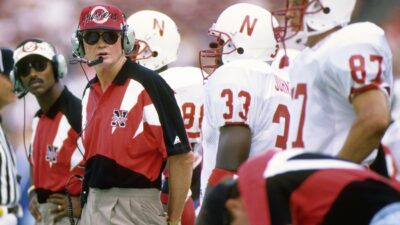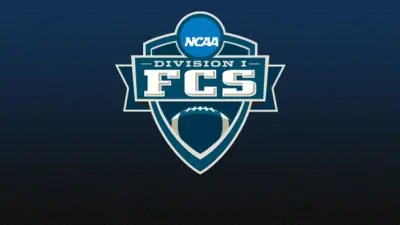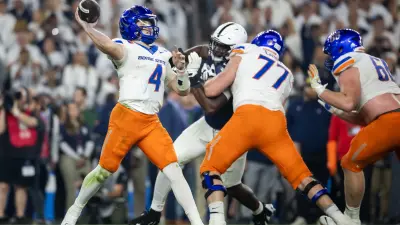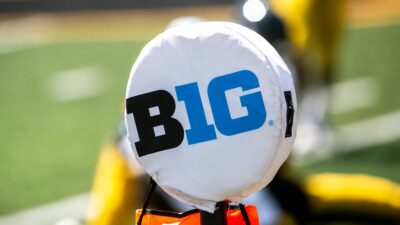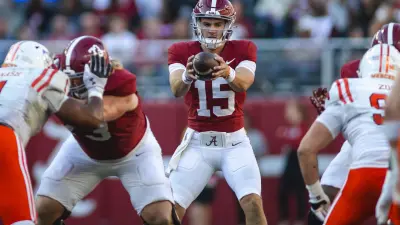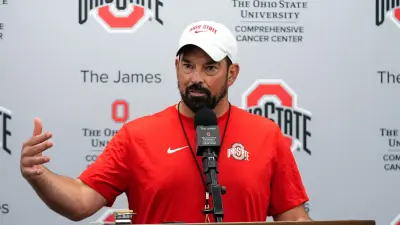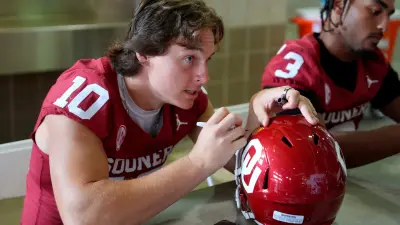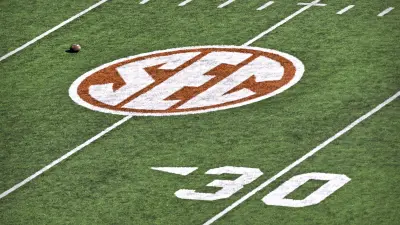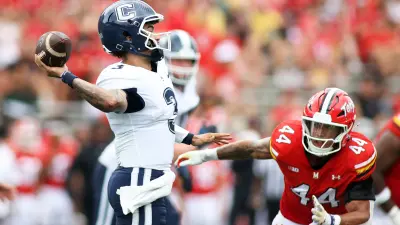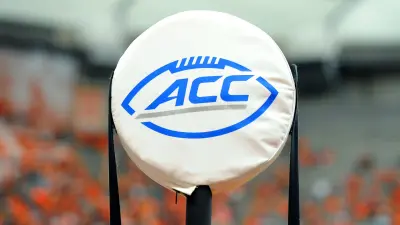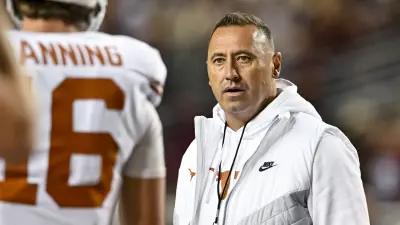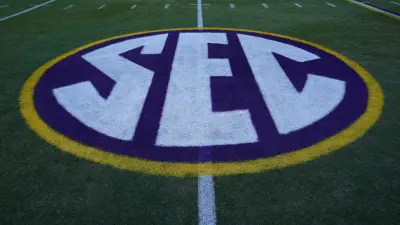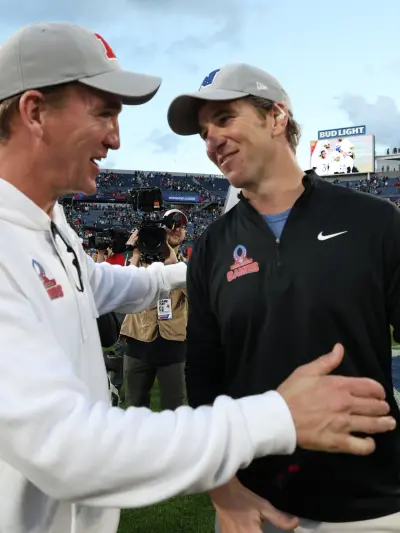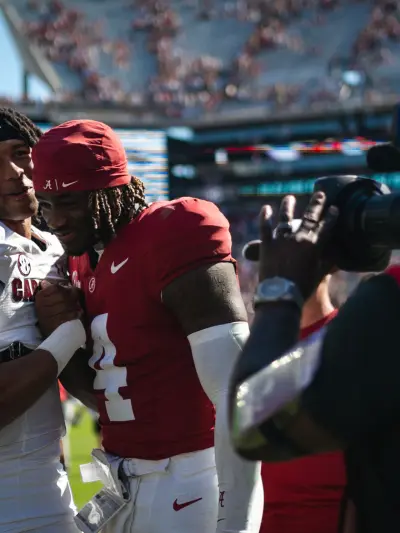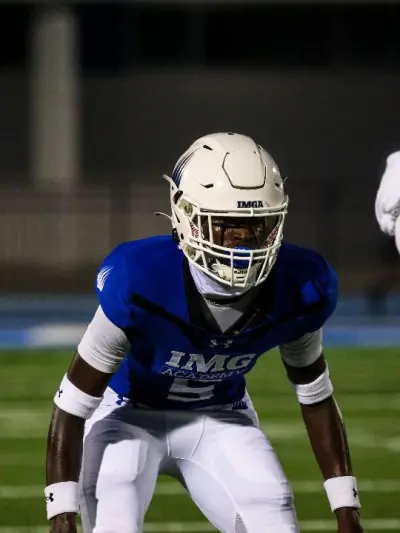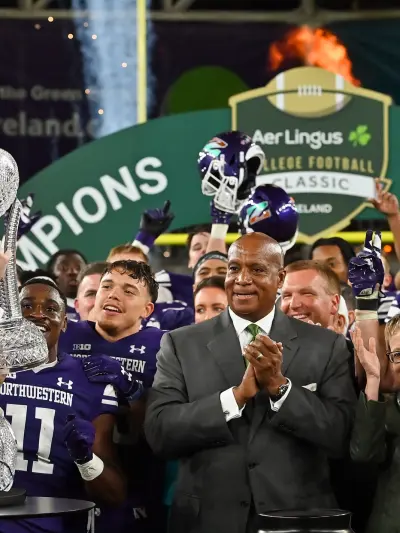When writing about Tom Osborne in our 1980s list of Coaches of the 1980s, Nebraska seemingly always came up short in the absolute biggest moments.
As the 1990s began, Osborne faced the harshest of critics from his fan base.
The reasons were justifiable, as Osborne would enter the decade on a three-bowl game losing streak, a streak that would reach seven consecutive bowl games, most Husker fans wondered if Osborne could ever win the big game for Nebraska.
Osborne’s predecessor Bob Devaney concluded his career going 33-2-2 with three Big 8 Championships and Orange Bowl victories.
Heisman Trophy-winning wide receiver Johnny Rodgers said in the Rites of Autumn documentary perfectly encapsulates the importance of winning at Nebraska, “Bob brought a tradition to Tom where we believed winning was not everything but we did rate it up there with oxygen.”
The standard Devaney set and for how long Osborne flirted with achieving that standard, Nebraska fans were getting frustrated and wondered if that would ever be realized.
Nebraska fans were a little more hopeful when Oklahoma head coach Barry Switzer resigned and the NCAA placed the Sooner program on probation. An opening seemed to be there for the taking for Nebraska, but a new challenger stepped up to meet Nebraska head-on.
More Sports News
Colorado, under the guidance of Bill McCartney, had risen to become a strong contender for the Big 8, taking most of the opportunity of the fallen Oklahoma dynasty.
When McCartney took over for Colorado, he designated Nebraska as their top rival and made Nebraska the goal. While Nebraska always had Oklahoma as their top rival, the ascension of Colorado put to the notion of the intense rivalry between both schools and Osborne’s first test of the decade.
In 1989, Folsom Field hosted a top-three showdown between Nebraska and Colorado. It was a game where all the big breaks seemed to go the way of Colorado. Two of those breaks came on two Jeff Campbell punt returns. The last was a pass interference call that damaged the Huskers’ hopes.
On the final Husker possession, Nebraska quarterback Gerry Gdowski connected with receiver Jon Bostick on a 42-yard completion. With the final seconds to go, Gdowski sent a final pass to the end zone targeting Bostick, but Colorado defender Dave McCloughan tipped the pass and Bostick watched it hit the ground.
The 27-21 win sent Folsom Field into euphoria and springboarded Colorado to their first Big 8 championship since 1976 and the No. 1 ranking.
As the Lincoln Journal Star headline said following the Nebraska loss to Colorado that the Huskers saw no beauty in the loss to Colorado, and that loss fueled them into the 1990 season.
Nebraska had a fast start in 1990, the Huskers got off to an 8-0 start and ranked No. 4 in the country. They averaged 43.8 points per game on offense in their I-Formation Triple Option attack led by quarterback Mickey Joseph, running backs Leodis Flowers, Derek Brown, and Scott Baldwin.
The trademark “Blackshirts” defense allowed only 8.25 points per game on defense and early in their Top 10 rematch against Colorado, they pounced early on and often on miscues by Colorado All-American running back Eric Bieniemy.
Bieniemy in the first three quarters fumbled five times in a 40-degree cold rain affair in Lincoln.
With the Huskers up 12-0 going into the fourth quarter, it looked like Nebraska would derail any remote chance Colorado had at a national championship.
Colorado earlier in the season had tied against Tennessee, lost to Illinois in a heartbreaker in Champaign, and needed a “fifth down” to escape from Missouri.
Then Bienemy went off, scoring touchdowns in the next four possessions to stun No. 4 Nebraska 27-12.
Osborne following the stunning defeat where the Blackshirts weren’t able to adjust said, “At the end, I thought we’d be the stronger team.”
It was the first of 11 losses Nebraska would lose under Osborne in the decade. Five of those 11 losses came to teams that would claim national championships.
If there was a blueprint against Nebraska, it was a deficit of skill possession players that possessed a combination of size and speed. There was no denying the strength and discipline Nebraska had, and their ability to stop the running game. When the Huskers went against powers like Florida State and Miami, they didn’t have the athletes to counter.
Colorado’s ascension with California imports in Darian Hagan and Eric Bienemy was the icing on the cake, especially with a downtrodden Oklahoma program. Nebraska needed to adjust if they wanted to take the next step.
By 1993, Osborne had begun to poach key pieces from across the country. He landed prized California running back Lawrence Phillips and Florida quarterback Tommie Frazier.
Along with junior running back Calvin Jones, Nebraska was potent and dangerous on offense averaging nearly 40 points per game. Phillips came into relief for Nebraska against Pac-10 champion UCLA for 137 yards and a touchdown to seal a 14-13 win.
This led to a collision course with Florida State in the Orange Bowl for the national championship.
The Seminoles had won three consecutive bowl games against Nebraska. The game will ensure that one much-maligned coach whether it was Bobby Bowden, who had to endure rising expectations due to Miami’s dominance of the 1980s, and Osborne, who seemingly couldn’t win the big one when it mattered.
https://twitter.com/1990sHuskers/status/1610981915909312523
It also featured a dynamic quarterback battle between Heisman Trophy winner Charlie Ward for Florida State and Frazier.
The game lived up to the hype, after a slow first half where the Seminoles and Huskers dueled like two heavyweight prized fighters, the second half became explosive.
In the third quarter, Florida State’s running back William Floyd scored a controversial touchdown where on the replay Floyd fumbled but the officials ruled it a touchdown.
At the start of the fourth quarter, Phillips inched Nebraska back on a 12-yard touchdown to make it 15-13. Nebraska attempted a two-point conversion to try to tie it at 15 but was denied.
Late in the fourth quarter, Nebraska drove to the FSU 10-yard line before stalling and hitting a 27-yard field goal with 1:16 remaining to take a 16–15 lead.
Aided by a special teams miscue by Nebraska where the kickoff went out of bounds, FSU took over with an excellent field position, Charlie Ward was able to drive the Seminoles to the Nebraska 3-yard line.
The Blackshirt defense held forcing a short FSU field goal attempt that was good to give the Seminoles an 18–16 lead with just 21 seconds remaining.
Florida State had their near-fatal miscue following the made field goal when Florida State sideline went into excessive euphoria in their celebrations and was subsequently penalized for excessive celebration, costing them 15 yards on the ensuing kickoff.
Nebraska capitalized on the miscue and got to the Nebraska 43-yard line.
As the final seconds ticked away, Frazier hit tight end Trumane Bell for a 29-yard gain to the FSU 28-yard line.
The clock seemingly expired, setting off more chaos on the FSU sideline.
The officials huddled and ruled that Bell was down with one second left on the clock, and ordered the field cleared, allowing Nebraska one last chance to win the game.
As Byron Bennett’s 45-yard attempt sailed wide left, it was another tough pill for Osborne to swallow.
The disappointment was on par with the 1984 Orange Bowl as even in one of the craziest final minutes in bowl game history, and every opportunity given to Nebraska to capitalize they couldn’t complete the mission.
With the taste of disappointment left in their mouths, Osborne and the Huskers’ motto heading into the 1994 season was “Unfinished Business.”
The biggest test for the Huskers came against a revitalized Kansas State team led by head coach Bill Snyder.
Dubbed “Futility U” by Sports Illustrated five years prior, Snyder had led K-State to a 9-2-1 record the previous season and their first bowl game since 1982.
Kansas State entered the game ranked No. 16 and was upset-minded because the Huskers were without their top two quarterbacks.
Frazier was out since the Pacific game due to a blood clotting issue doctors were trying to figure out, and backup quarterback Brook Berringer was still nursing a collapsed lung and saw limited action in the contest.
Osborne turned to third-string quarterback Matt Turman in his first career start to fend off an upset-minded Wildcats at KSU Stadium.
Turman relied heavily on an elite ground game and the Blackshirt Defense to thwart the upset attempt.
This worked majorly as Nebraska ran the football 50 times for 210 yards, led by Phillips who had 126 yards on the day, one of his 11 consecutive 100-yard rushing games in the 1994 season.
The Blackshirt Defense was stifling and held Kansas State to negative seven yards rushing on 23 carries.
It was a signature and great character win for Nebraska, one that in the past would cost the Huskers a perfect season and be that head-scratching loss. Tom Shatel of the Omaha World-Herald would characterize the Huskers’ effort as “Nebraska took this fork in the road and stuck it in Kansas State.”
As the 1994 season progressed, Berringer recovered from his collapsed lung, and on the dominance of Lawrence Phillips, Nebraska would defeat Colorado in a Top 3 matchup at home 24-7 and take advantage of two lackluster Penn State performances against Illinois and Indiana to become the No. 1 team in the country and they didn’t look back.
Nebraska would once again face a familiar nemesis in the Orange Bowl for the national championship in Miami.
The 1994 Hurricanes were led by two future Pro Football Hall of Famers in defensive tackle Warren Sapp and linebacker Ray Lewis and the Hurricanes had won three consecutive Orange Bowl matchups against Nebraska including the 1992 Orange Bowl that secured Miami’s fourth national championship in school history.
https://twitter.com/ClassicsCFB/status/1521212467656806401
NBC who broadcast the game had the narrative for Nebraska that Tom Osborne was chasing his elusive first national championship.
Osborne gave Frazier the start, but early in the contest after a costly turnover, Osborne reverted to Berringer.
While Nebraska ground away physically against Miami, it wasn’t able to translate on the scoreboard trailing 17-7, the Blackshirt defense was beginning to thwart a potent Hurricanes offense, and the key play came when Nebraska linebacker Dwayne Harris sacked Miami starting quarterback Frank Costa for a safety to make it 17-9.
With the momentum beginning to swing, Osborne put Frazier back into the game, and the magician of Osborne’s vaunted triple-option attack was an integral part of the comeback.
Frazier had key keepers in the triple option that kept the Miami defense guessing, and his option wizardry gave fullback Cory Schlesinger wide-open holes for two fourth-quarter touchdowns that would be the deciding factor.
Tom Osborne was finally a national champion, after many crippling and cruel defeats to Oklahoma, at Penn State in 1982, the 1984 Orange Bowl in Miami going for the win, and the 1994 Orange Bowl that had a crazy finale to it, the victory was arguably the sweetest in Osborne’s entire career.
Following his 1994 national championship season, Osborne had not only his coaching opus but arguably one of or maybe the greatest single-season team of all time.
How great were the 1995 Nebraska Cornhuskers?
- They averaged 53.2 points per game on offense and allowed only 14.5 points per game averaging nearly a 39-point margin of victory.
- Offensively scored at least 35 points in every single game.
- They were never challenged in any single game, defeating each opponent by 14 points or more.
- They defeated four Top 10 ranked teams by nearly 31 points per game with the average score in those four contests being 49 to 18.
- They set an NCAA record averaging seven yards per carry as a team – averaging 57 attempts per game for 399.8 rushing yards per game. The Cornhuskers had nine of their Top 10 players in yards per play average at least 6 yards per touch (minimum 20 touches)
Even with the exceptional dominance heading into the Fiesta Bowl against No. 2 Florida, there was still skepticism that the Cornhuskers would deliver against an elite aerial attack in the Fun ‘N Gun approach head coach Steve Spurrier implemented.
There were some interesting reasons why some analysts thought Florida would beat Nebraska, notably from ESPN’s Lee Corso.
Corso reasoned that the game was on grass. Nebraska played most of its games on AstroTurf at Memorial Stadium, while Florida had played on grass all year at The Swamp and the Fiesta Bowl was a grass surface.
Early in the Fiesta Bowl, Corso looked like a genius with Florida holding to a 10-6 lead, it looked like Florida may have proven correct.
What Corso, the Gators’ defense, and the rest of the nation weren’t expecting was an avalanche in the second quarter outscoring the Gators 29-0 and scoring 36 unanswered points.
If that didn’t stun the Gators, it would be at the end of the third quarter, quarterback Tommie Frazier would become a Nebraska and college football immortal on what would be known as “The Run.”
https://twitter.com/1990sHuskers/status/1539937164313731074
Frazier had gained first down yardage before running into a pack of Gator defenders, Frazier outmuscled and got out of the pack breaking seven tacklers, and streaked 75 yards for a touchdown.
The 62-24 rout of Florida was a finishing statement for a team that many still consider the greatest team of all time. Nebraska set numerous records that day, notably were most points scored in a national championship victory and the most rushing yards with 524.
Nebraska was primed to play for a fourth consecutive national championship entering the 1996 season, but most of America was stunned by the events that happened in Tempa as Nebraska visited Arizona State.
They often say in Pac-12 circles, strange things happen when you head to the desert to play a game, and for a game that kicked off at 10:15 PM Eastern, it was a stunner that you had to do a double take to see Arizona State not only defeated Nebraska but shut them out 19-0, their first scoreless affair since the 1992 Orange Bowl loss to Miami.
When Nebraska got back on track, it would be in the first-ever Big XII Conference Championship Game more history would happen. Things seemed to go right every time for John Mackovic’s unranked Texas Longhorns.
One of the signature plays for Texas came in the fourth quarter trailing 27-23, Texas quarterback James Brown connected with wide receiver Wayne McGarity on a 66-yard touchdown reception. It gave Texas the momentum to complete the 37-27 upset of No. 3 Nebraska. It would be the final loss of Tom Osborne’s coaching career.
1997 was Osborne’s swan song and included some memorable moments, most happening at Faurot Field against unranked Missouri.
It would be known in Nebraska annals as “The Flea Kicker.”
Trailing 38-31 with 1:02 left in regulation, it looked like Tom Osborne was a last gasp away from snapping an 18-game winning streak against Missouri.
Nebraska was able to drive to the Missouri 12-yard line with seven seconds remaining, quarterback Scott Frost targeted intended receiver Shevin Wiggins with a pass at the goal line.
The ball ricocheted off Wiggins’ foot into the air, and an alert receiver in the area Matt Davison caught the ball for Nebraska to get the critical touchdown.
Nebraska would win in overtime 45-38, preserving their chances at a national championship.
Tom Osborne’s final game as head coach was in the Orange Bowl against the Tennessee Volunteers led by quarterback Peyton Manning.
Nebraska would score first and would never trail in the contest. Running back Ahman Green set an Orange Bowl record with 201 yards rushing and touchdowns, the Huskers held Manning in check and won the game 42-17 to win a share of the national championship, the third national championship in four seasons.
No coach in my lifetime has had as big a reversal of fortune at a major program like Nebraska like Tom Osborne demonstrated.
He was arguably the biggest hard-luck coach in history, and you really couldn’t blame him. Things you couldn’t imagine happening in a game would happen. Osborne always demonstrated the courage of doing the right things at the right times, even if it wasn’t fully advantageous. I outlined this for his call in the 1984 Orange Bowl going for the win in my 1980s piece.
The 1990s demonstrated that the patience for those who extended it to Tom Osborne was rewarded in the end, had one of the most dominant peaks in college football history going 60-3 in his final five seasons, playing for four national championships, winning three of them and on our list at No. 2 of top coaches of the 1990s.
